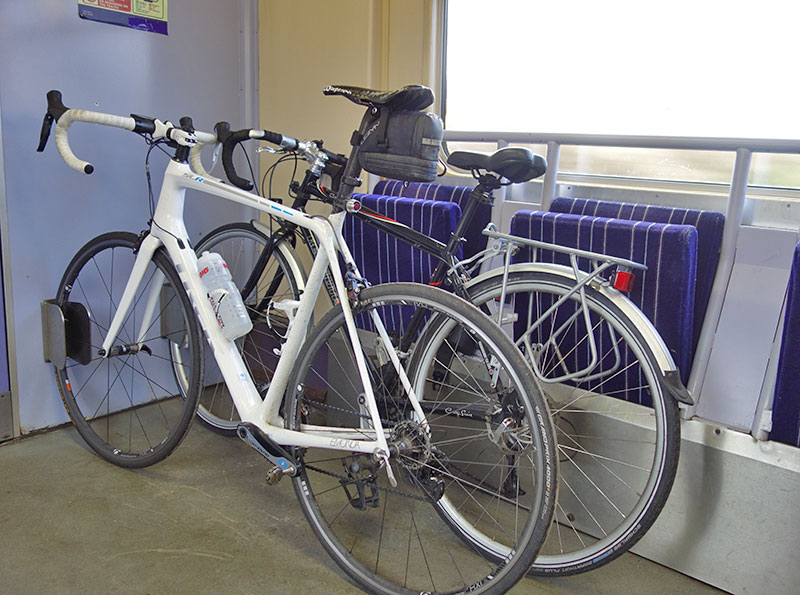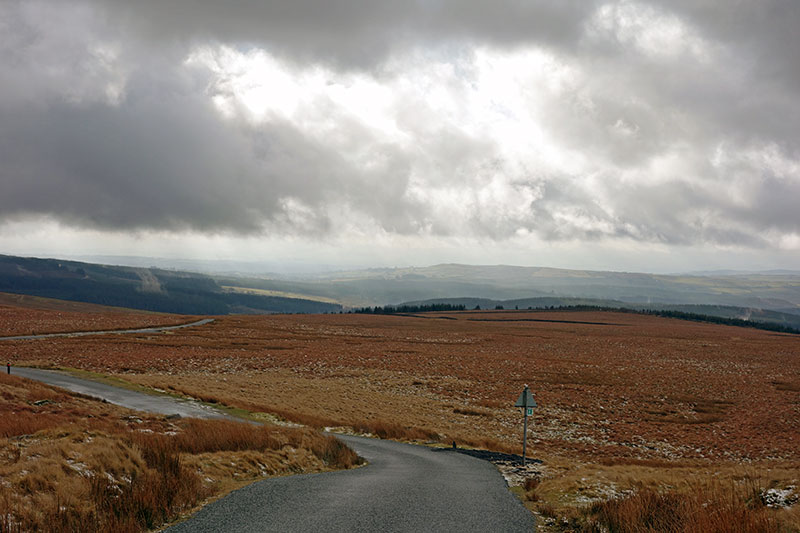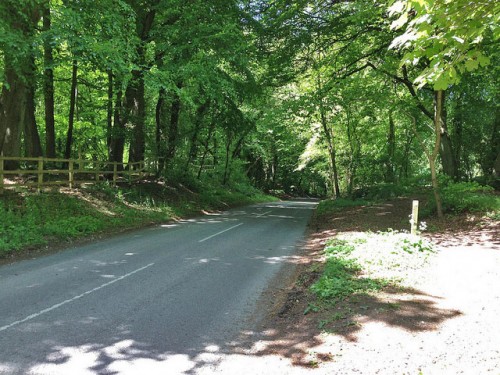After a lot of climbing in the rain on Wed, today was a slow plod in the sun. An excuse to go slow, admire the Yorkshire Dales and take a few photos.
It’s quite nice to go slow for a change.
After a lot of climbing in the rain on Wed, today was a slow plod in the sun. An excuse to go slow, admire the Yorkshire Dales and take a few photos.
It’s quite nice to go slow for a change.

The weather forecast for today was sun and westerley wind. I thought I would be clever and get a train from Bingley to Clapham and avoid a long slog into a headwind. It partly worked out because the wind was strong, but ‘light occasional showers’ obviously means something very different west of Settle.
First up was a new climb south from Clapham towards the Trough of Bowland called Bowland Knotts. It is a climb from 100 climbs, and I probably wouldn’t have thought of taking this road without a desire to tick off a few more climbs in the book. The road was certainly very isolated and quiet. In a long ascent and descent, I think I only saw one car, four people and a dog. It’s not mid-summer, but if you’re looking for traffic free roads, this is as good as it gets.
The climb is a long drag of 4 miles plus – averaging only 4%, but with a strong side wind, it was tough going, though some great views partly compensated. Looking back down the hill, it reminded me somewhat of the bleak open climb of the Stang in North Yorkshire. Though this climb has no 17% gradient to start off with.
Whiteleaf is one of the hardest climbs within striking distance of Oxford. It has often been a place for some hill climb training.
There is a hilly event on the course (Hcc212) which includes two ascents of Whiteleaf, promoted by Watford Velo CC on 17th April. Unfortunately, I am away in NY, but was interested to check out the course.

I have recovered from a cold, but two weeks of little cycling has reduced form. Still I went out and did a few hill intervals on the way to Princes Risborough. I started at the bottom of Whitleaf, and then followed the 7 mile circuit , which includes quite a few left turns. I finished with a final ascent of Whiteleaf.
It was 7.9 miles, average speed 17.7 mph, average power 274 watts. I was already a bit tired by the time I got to Princes Risborough, but that is a very slow average speed for a circuit. It is up and down with a few left hand turns you have to slow down for. Whiteleaf really kills your average speed.
The real course starts on the top of Whiteleaf hill and does two laps 14 miles, with two ascents of Whiteleaf. The course could be amended to make it 15 miles and 3 ascents of Whiteleaf. But, I’m not sure how popular that would be!
Maybe next year I will be around to do. It’s a shame to miss out on a time trial course which has two ascents of a climb like Whiteleaf.
Course
Friday is Buxton Mountain Time Trial, but then there is a big gap in racing because Circuit of the Dales has been cancelled.
Related
It’s been a real stop-start season. Last week I was busy with other things, such as Peace Run coming to Oxford. This week, it’s another cold/flu. Unfortunately, I’ll probably miss first round of RTTC series 1, which is a shame. The early season hillies are the main target of year for .
Recently, there’s been a lot of press about the role of (both legal and illegal) medication and its use for performance enhancing properties. As an athlete, I’m fortunate to be quite healthy, and I rarely take any medication or supplements. I would not feel comfortable taking medication where there is a potential performance enhancing effect – even if legal. The main thing is to follow the rules, but I also believe there is such a thing as the spirit of the laws and not doing anything you wouldn’t be happy for other competitors to know about.
Most cyclists are self-taught. We learn on the job – when the bike stops working, we either read a manual and try and fix or we give up and take to a bike shop. Some people are quick learners, and are adept at learning all the necessary requirements to look after a bike. Others, like me, are a little embarrassed that after 20 years of cycling we’re still not 100% sure where the seat tube is.
How to train – is a whole different learning curve. In the beginning, you can get faster by riding a bike, but then you become aware of a whole world of heart rates, training zones and recovery. So you try and read a few books and absorb the information which you like the sound of.
But, just as you think you’re getting to know all about cycling, there is a scientific revolution, leaving a battery of new training terms related to power and critical threshold power. Just to increase the complexity, usually, these training terminology are abbreviated to three letters like FTP, CTL, and TSS.
If you can wade through that, you are now ready to worry about your CdA (aerodynamics) and Watt / CdA. Which requires several hours of testing, plus the required computer skills to punch in the numbers and get something meaningful out of the other side.
I remember reading Ned Boulting’s ‘How I won the Yellow Jumper‘ – an entertaining look at someone thrown in at the deep end of professional cycling. Boulting was asked to cover the Tour de France with pretty much zero knowledge of cycling, Ned endured a crash course in how to talk about a sport you don’t really know anything about. (Ned was doing pretty well, until he got the Yellow Jersey and the Yellow jumper mixed up)
Cycling is one of those subjects where you have to learn everything by the process of osmosis – slowly picking up on the jargon and knowledge as you go along – without ever really admitting you didn’t know about it in the first place. It’s very rare someone will sit and down and explain the mechanics of adjusting your gear cable or even worse – Never try asking what a peleton is, 1 km from the finish of a Tour de France stage (note to family members! see also: Explaining the Tour de France) The only way to learn about the jargon of the Tour de France is to many hours ever day for three weeks over several summers, like I did. I don’t see why anyone should get any shortcuts.
From: Aaron’s site
It is only fairly recently that I’ve worked out the different parts of a bicycle – and that was thanks to a pretty handily marked diagram.
A typical weather forecast for the past few weeks. Trying to find a bit of dry weather to go cycling. I went out at 14.00 and got lucky. Proof you shouldn’t always trust the weather forecast.
Sometimes, when I see a weather forecast I don’t like, I try another one, until I see something a bit more promising. Any cyclist becomes a devotee of rain forecasts. The ones I use are
More weather sites recommended by readers
Often, once you get on the bike, rain isn’t so bad. But, when it’s raining outside, its tempting to try and find better things to do, and hope it clears up.
**
This week has been quite light on training, a few winter niggles still playing up. It’s that kind of niggle, that you can probably ride through, but you’re not entirely sure. It makes you think of Daniel Sturridge – a career plagued by injuries. Football pundits say he should just keep playing and stop being so soft. But, it’s hard to know unless you have the injuries yourself. But, this isn’t pain, just tiredness. Unfortunately, my sport physio seems to have closed down.
With the prospect of rain looming, I went to the Cow and Calf Ilkley, just five miles from Menston and a good climb. Mostly cross / tailwind up the climb. A few hard five minutes efforts. But, not 100%.
Cow and Calf
Cow and Calf – 1.2 miles @11%
Early February is time to get the time trial bike down from the loft. I last rode the TT bike back in September, and that was a short hill climb in Buxton. I have done a few perfunctory core strength exercises over the winter, e.g. the plank for one minute a couple of times per week, 20 sit ups since Jan 1st, but nothing like enough to get the body ready for a super, uncomfortable, aerodynamic position.
Despite the initial physical discomfort of riding a TT bike – on the positive side it is always a boost to get on the time trial bike, after a few months on a relatively slow winter training bike. Suddenly you feel as though you’re flying along. In fact in previous years, I’ve joked that getting on TT bike can feel like getting on a motorbike, as you race around town at 20mph +. But, alas, that innocent observation no longer seems quite so innocent given recent shenanigans in Belgium and depressing evidence of hidden motors in bicycles. It’s both a tragedy and farce, and not much comedy, save a little related news about participants and a stolen parrot, “A Norwegian Blue” I presume.
A popular bit of banter at local time trials was for a slow ride to joke to a fast rider – “Have you got a motor in there?!” This banter is all said in good fun, but now, it might not be so funny any-more. Especially, if bike was left unattended for a long time…
Anyway, the crazy world of cycling can’t change the essential practice of cycling which is to pedal a lot until it hurts. And if you’re riding a time trial bike for the first time in five months, you can guarantee it will start to hurt in quite a lot of places you had forgotten all about.
On Tuesday, I did quite a hard 75 mile ride to Stow on the Wold. I averaged 18.5 mph, which was a high average speed, given it was quite windy. I’m trying to do some sweet spot training at around 250-70 watts. I managed this for the first two hours grind into the wind. On the way back, I eased off the power, but went faster with nice tail wind behind. It’s great fun cycling with strong tailwind, but this persistent Westerly wind is getting a bit tiresome. It’s hard work going west.
Yesterday, I did a steady two hours on the time trial bike. I’m glad it was no longer than two hours, as I felt quite sore in different parts of back, and even legs. Although, it was a relatively easy ride on power, it felt quite tiring. Moral of the story, if you want to race on a time trial bike, you have to train a lot on the bike too. Ideally, I would have been riding on a time trial bike all winter. But, I don’t like getting the new bike spoilt by salty wet roads. Anyway from now on the TT bike, will be used most rides. The good news is that once you start training on the bike, the body adapts and initial discomfort becomes much more manageable. Last year it got to the situation where I found a TT bike more comfortable than a road bike.
Training on time trial bike
Related
Vic Clark, three times former national hill climb champion (1946 to 1948) sadly passed away recently. He was aged 96.
Paul Jones interviewed Vic Clark for “A Corinthian Endeavour“, in which Vic has a starring role in the first chapter.
I’d like to post this interview with Vic because it is a great story and evocative of a very different post-war era where you could commute from Coventry to Kendal and be as quick as a van.
I particularly like the story at the end. The time when Vic was cycling a tandem on his own. He stopped to pick up a soldier trying to hitch-hike home. Vic offered him a lift but said ‘you’ll have to work for it!’ The solider accepted and cycled on the back.

Vic Clark was the third person to win the national hill climb championship in 1946. Well into his nineties, he would still ride his bike on indoor rollers. He continued to take an interest in the hill climb championship in the evening of his life.
I found this video on youtube. Live coverage of the British Time Trial Championship June 2015.
I was joking with race official before the start and the commentator (Rob Hayles) picked up on this.
The funny thing I never usually do this before the start of the race.
I was talking because the clock in front was confusing. There was a count-down, but it seemed to be a minute out and I thought I might have to start a minute before the official time.
Usually before a race I’m quite quiet and don’t feel like talking. Sometimes people will ask questions, but I’m not in the mood for talking. Just trying to keep my mind quiet and focused on the upcoming effort.
It’s the time of the year when I would like to be impressing my readers with tales of daring winter rides through the biblical floods of South Oxfordshire or the frozen lanes of the Chilterns.
In previous years, I’ve told about epic homemade sportives like the “Hell of the B4135 and related minor roads” – mud, potholes and lonely winter roads, with the only companion the mileometer slowly clocking up the miles.
Fortunately or unfortunately, I have no epic tales to tell this winter. I’m more like the sickly boy at the back of the class who always has a note from his Mother to excuse him from games. I have had a few days of training in Sicily which was pretty good. But, mostly it’s been stop / start – a few days on, two weeks off. The worrying thing is I feel quite fine about it. I hope the article “Not everyone can be Eddy Merckx” isn’t a portent of things to come. The old competitive urge wearing away as I start to get used to pottering around the house in a pair of comfy slippers.